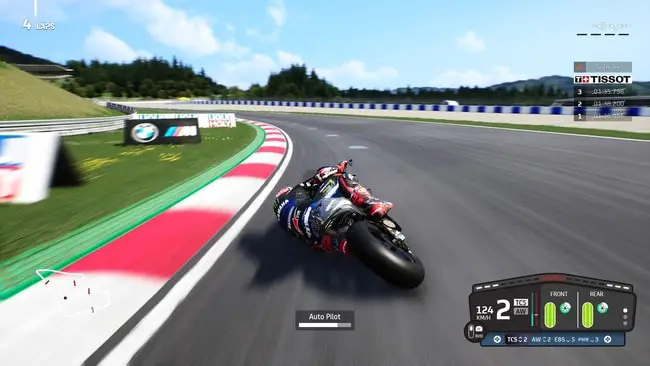This was a frustration of mine playing the very tricky MotoGP 22 game recently, but it’s really the case on all the MotoGP games. If we’re not used to how these bikes handles – especially the powerful MotoGP class bikes – we can find ourselves constantly over-running or over-shooting the apexes of corners, and never quite making them consistently enough to string together consistent laps.
It’s never too long before we’ve run wide on another corner and are on the grass/gravel, which on this game is an almost guaranteed way to fall off. What can we do to deliver more stopping power, make the braking easier and more effective, and make the corners consistently?
To corner more consistently on the MotoGP games, be sure to brake and turn in early and hard enough using both the front and rear brakes if necessary, and also use the Ideal Trajectory driving aid. Increasing the Engine Braking value and brake disc size also helps deliver more stopping power.
The engine braking hack is something I just found and makes a BIG difference, so let’s look at these tips in a bit more detail.
Tip #1 – Brake & Turn In Early Enough
The first and most basic cause of inconsistency and over-running corners on MotoGP games is that you’re braking and turning in too late.
Whatever muscle memory you have for braking/turning at any given track for other racing games (especially 4 wheel cars), you need to discard for the MotoGP games. It’s a totally different braking and turning technique that’s required and the stopping distances are much longer than other racing formulas.
Therefore be prepared to brake and turn in much earlier than you’re maybe used to on other racing games, in order to make corners properly.
Also make sure the Ideal Trajectory assist is enabled from the Race Options menu. This helps a lot, but with the MotoGP class bikes especially, I like to pull off the accelerator even just BEFORE the line tells me to brake and coast for a short while, before then applying the brakes. I find this gives me more “wriggle room” with the stopping distance and stops me over-running the corners so much.
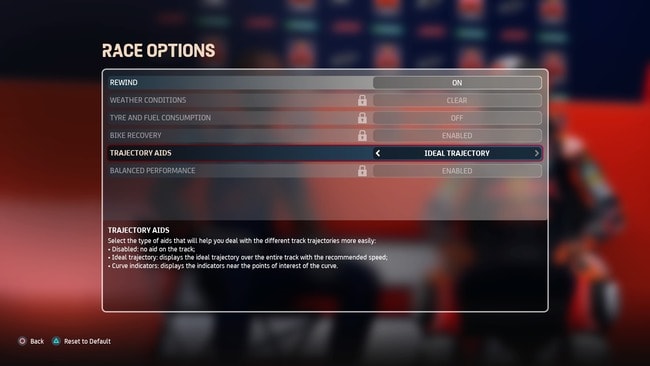
This provides a line that gives you a rough idea for when to brake and turn in. However, even this line isn’t perfect at times, especially for the MotoGP bikes, and I find myself braking sometimes even before that line tells me to in order to avoid over-running corners.
On these MotoGP games, always err on the side of braking too early rather than too late, since it’s very difficult to recover if you over-run corners and end up off track.
And then here’s a general brake/turn in method to properly make corners and not over-run them:
- Get your braking done mostly in a straight line and with the bike upright (not leaning), well before the corner.
- Apply the front brake first
- Apply the rear brake also if needed as a complement to add more stopping power in especially hard braking zones or sharp corners or if you find yourself missing a lot of corners. On some older MotoGP games before 2022, there’s an input to apply both the front and rear brake together, which makes it easier.
- Once you’ve scrubbed off enough speed to make the corner, release the brakes and lean the bike into the apex
- Once past the apex, ease back on the throttle and exit the corner.
See my guides on how to brake properly on MotoGP 22 and MotoGP 23 (much of the advice applies for all MotoGP games) for more info and applying the correct braking and cornering technique.
Tip #2 – Increase The Engine Braking Setting
This is a great little hack I just found in the Electronics/ECU settings on the bike setup. The Engine Braking parameter trades off braking power from the engine for grip.
Increasing this setting gives more stopping power at the expense of slightly less grip.
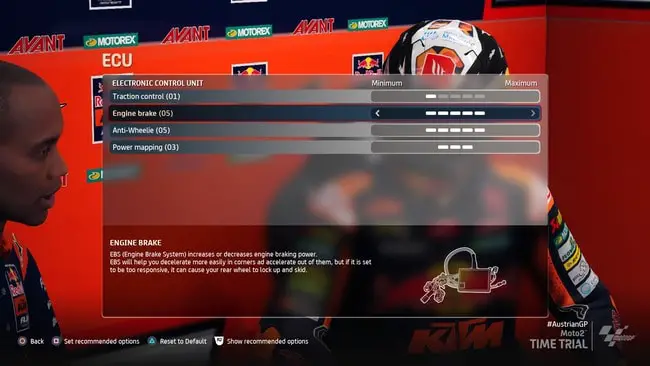
From my own experience so far, increasing this just from 4 to 5 made a massive difference in the MotoGP and Moto2 bikes especially. It delivered noticeably more braking power and I went from constantly over-running corners in a MotoGP bike at Austria to being more consistent and mostly making them. I also didn’t really notice any less grip.
Therefore increase this setting to Maximum if you’re constantly over-shooting corners and see if it helps.
Tip #3 – Use A Larger Brake Disc
Another car setting that directly affects stopping power and therefore consistency is the size of the brake disc you use. Using larger brake discs deliver more stopping power at the expense of cornering performance and perhaps some locking and overheating.
But on any track where you find yourself constantly overrunning corners, using larger front and rear brake discs can help increase braking performance. Go to the Braking System tab of your Track Engineer menu to adjust this.
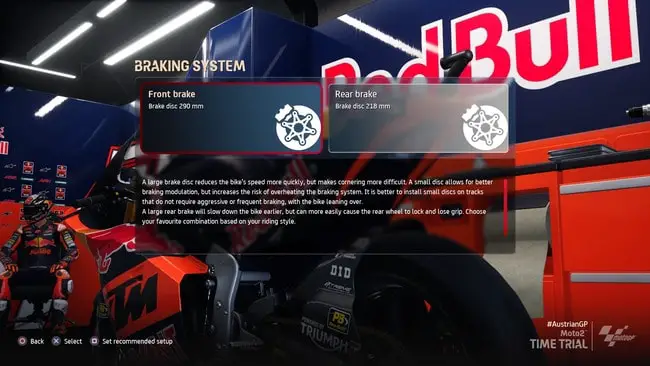
Here’s some good baseline front and rear brake disc sizes to use:
- Moto2 – Front Disc 290mm; Rear Disc 218mm
- MotoGP – Front Disc 355mm; Rear Disc 220mm
Tip #4 – Get Used To A Totally Different Handling Model
If you’ve been a frequent player of the F1 games as I’ve been, getting used to the MotoGP games is an even harder task, because the braking and turn in model is very different and in many ways the OPPOSITE of what it is for F1 sim racing.
It’s not about braking as late as possible and going super deep into corners, trying to find every last hundredth or thousandth of a second, like in F1. Part of me is still trying to do that, and it’s causing me to brake too late on these games and keep running off track.
In fact, with MotoGP, it’s kind of the opposite – you have to be really restrained and coast and brake much earlier, since the brakes are far less powerful and the stopping distances are much longer. It’s a totally different muscle memory to learn and it’s more about rhythm and patience with these games, almost like a “less is more” mindset in the sense that being more restrained actually seems to bring better lap times and more consistency.
With the insanely fast accelerating MotoGP class bikes especially, you’re actually not on the accelerator very long at all except on the longest straights. For short and medium length straights, it’s literally just a quick squirt on the throttle before you need to be slowing down and back on the brakes again, and there’s a lot of coasting as well just to get round twisty sections.
Here’s a process I’m following right now to try and build better rhythm and consistency on the game and not over-shoot corners so often:
- On longer straights, as you approach the braking zone, lift and coast for a short while, until the Ideal Trajectory line turns green.
- Once it does, go hard on the front brake with the bike upright, and add rear brake as well if desired for more stopping power.
- Scrub off most of the speed in a straight line, and lean in once you’ve slowed down enough make the corner.
- Hit the apex and then get ready for the next corner.
-
- When there’s only a very short straight or section before the next turn, only the slightest dab or burst of the accelerator is needed for MotoGP and Moto2 bikes, nothing more or you’ll over-shoot
- When there’s another corner immediately after that corner, literally no accelerator is needed – just coast and turn for the next corner.
-
- Keep repeating this until you build confidence and rhythm on a track and find yourself making corners more and more often, and over-running and falling off less and less.
- As you get more confident and consistent on a track, then you might start to very gradually push slightly harder and try to find time under braking in certain corners.
Treat it like an F1 car where you’re running as far as possible into the corners, and you’ll always be over-shooting. That’s what I need to get out of my system and learn to just smooth and consistent with my braking and turn in.
I’m also finding it helpful to really visualize the circuit layouts and be consciously aware of where the “flat out” sections are versus the tight/twisty/technical sections. Once I’ve got any medium/long straights out the way, it’s like I’m telling myself “right, flat out accelerator is out the way now until I get back round to the long straight. For the rest of this lap, it’s just restraint – short dabs and squirts on the power, but that’s it”. And block every track into sections – where can I nail the accelerator, where do I need to be cautious? And try to get into a rhythm.
Check out this video of a guy who was really good on this game – look at how he’s fast without really looking like he’s pushing and is even finding the AI too easy. He’s just smooth and consistent and brakes early for corners, yet still beats the AI easily. That’s what I need to be more like playing these MotoGP games.
Use Moto2 or Moto3 Bikes Instead
Another important thing to point out is that the slower accelerating Moto2 and Moto3 class bikes are much easier to control and be consistent with than the MotoGP bikes.
They deliver less power, have lower acceleration and top speed and in general it’s just far easier to make corners properly and stay on the bike riding these bikes. Therefore switch to them at least temporarily if you’re struggling to take corners properly on the insanely powerful MotoGP bikes.
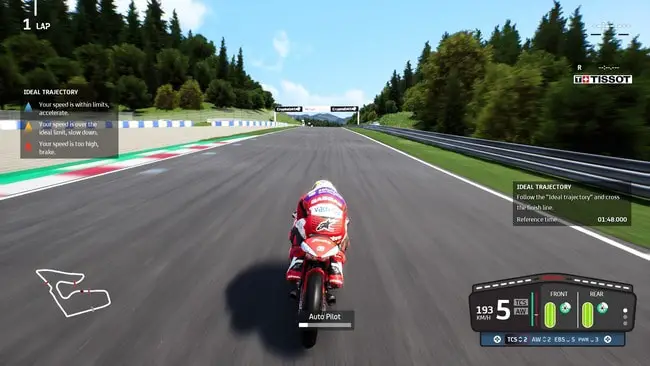
The braking distance for Moto2/Moto3 bikes are comparable to those of GP bikes, but the because everything is moving much slower, it’s just easier to react to what’s coming, position the bike correctly for consecutive corners, correct small mistakes and avoid running off track altogether.
In relative terms at least, it’s a lot easier to be consistent and stay on the bike riding Moto2/Moto3 class, so pivot to this for a while if needed to build up your confidence and knowledge of tracks.
